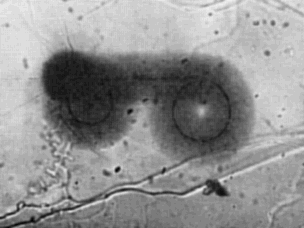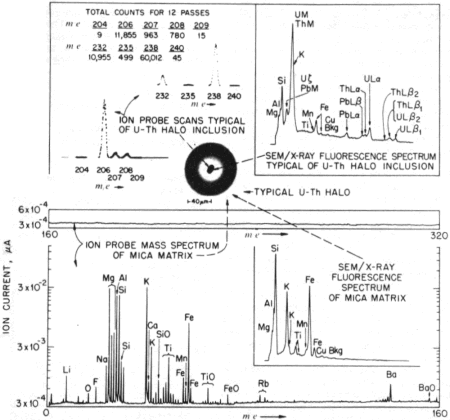|
Earth Science Associates |
||||||||||||
|
|||||||||||||
|
Creation's Tiny Mystery |
|||||||||||||
|
|
< Prev T of C ... 12 13 14 15 Epi. Cat. App. Ref. Cred. Next > (reprinted from Nature, Vol. 252, No. 5484, pp. 564−566, December 13, 1974)Polonium radiohaloes occur widely and not infrequently (total about 1015−l020) in Precambrian rocks but their existence has so far defied satisfactory explanation based on accepted nucleocosmogeochemical theories1. Do Po haloes imply that unknown processes were operative during the formative period of the Earth? Is it possible that Po halos in Precambrian rocks represent extinct natural radioactivity2 and are therefore of cosmological significance? A detailed comparison between an unusual array of Po halo radiocentres and U−Th halo radiocentres is presented here as bearing on the above questions. Generally, radiohaloes occur in one of several mineralogical contexts1, 3, 4. First, as single haloes around discrete inclusions well isolated from other mineral defects and haloes; second, as single haloes around discrete inclusions lodged in conduits or cleavage cracks; third, as single haloes randomly spaced in clusters (sometimes overlapping); fourth, as vein haloes which formed from a continuous distribution of radioactivity (apparently deposited from hydrothermal solutions) along a conduit; and fifth, as line haloes, which surround, not conduits or cracks, but genuine single inclusions which are long (for example, 25 μm) compared with their width (perhaps 1 μm). Large, amorphous, coloured regions without discrete inclusions are not haloes.
A striking exception1 to this classification is the 'spectacle' coloration pattern (Fig. 1), which exhibits two almost circular rings of inclusions joined by a linear array of inclusions. As far as we know this is unlike any group of haloes previously seen. This geometrical arrangement of halo radiocentres, found in a Precambrian biotite from Silver Crater Mine, Faraday Township, Ontario, exhibits true radiohalo characteristics. First, the coloration is identical to that of normal haloes found about 300 μm away in the same mica specimen. Second, the three-dimensional nature of the halo pattern was demonstrated when the specimen (initially about 50 μm thick) was cleaved; both halves revealed matching 'spectacle' coloration patterns, the only difference being the presence of the inclusion array in one half and its absence in the other half. Third, the radius of the coloration band (18.5 μm) implied an origin from 210Po α decay. Mass spectrometric and X-ray fluorescence methods were used to ascertain whether this was indeed a Po halo array. Before applying these techniques to the 'spectacle' halo, we established that ion-microprobe mass analyses and scanning electron microscope X-ray fluorescence (SEMXRF) studies of 'normal' or 'standard' halo radiocentres (those formed from both U and Th α decay) yielded data consistent with the visual means of identification. Several U−Th haloes (see, for example, photo insert, Fig. 2) found in a Precambrian pegmatitic mica from Rossi, New York, were analyzed by X-ray and ion-probe techniques. Several U−Th halo radiocentres were chosen which contained only U, Th and Pb in any significant abundance, thereby virtually eliminating any molecular ion interference in the Pb−Th−U region (m/e = 204−238) in the ion probe.
That the mica matrix5 yielded insignificant molecular ion currents in the region m/e 160−320 is evident from the data in the lower portion of Fig. 2. In contrast, the recorded spectra of a U−Th inclusion (upper left portion of Fig. 2) revealed a significant number of ion counts accumulated in 12 passes of the regions m/e 204−209 and (with a different scale) m/e 232−240. Total ion counts are tabulated just above the two spectra. The scans on the Pb−Bi region (m/e 204−209) lasted for several minutes and were taken before the scans (equal time) on the U−Th region. Exact 206Pb/238U and 208Pb/232Th ratios are not obtainable from the ion count data in Fig. 2 because variable U and Th concentrations were observed as the ion probe beam sputtered away the inclusion; accurate ratios could be obtained by simuitaneously accumulating counts in the region 204−238 provided that the greater secondary ion yield of U and Th as compared with Pb is taken into account. On the other hand, the separate Pb and U isotope ratios are meaningful. Note, for example, that after subtraction of background counts at m/e 240 from the total counts at m/e 235 and 238, the 235/238 value (0.76) satisfactorily approximates (considering the relatively small number of counts collected) the natural U isotopic ratio, 235U/238U = 0.72. The absence of a peak at 204 shows there is little or no common lead in the inclusion and therefore, that the 206/207 ratio is that of 206Pb/207Pb as derived from in situ U decay. Also shown in Fig. 2 are the SEMXRF spectra of the mica matrix and the U−Th halo radiocentre, both of which correlate well (with the exception of the low Z and low abundance elements in the former) with the respective ion-probe spectra. Only U, Th and Pb are exclusively in the inclusion.
Doc.: T of C ... #2 #3 #4 #5 #6 #7 #8 #9 #10 ... < Prev T of C ... 12 13 14 15 Epi. Cat. App. Ref. Cred. Next > |
|
||||||||||
|
|
|||||||||||||
|
|||||||||||||
|
Earth Science Associates
|
|||||||||||||




